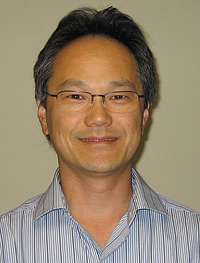Turner Sports Graphics Sparkle With Orad
by Tom Sahara
Senior Director Remote Operations & IT
Turner Sports
ATLANTA
When I entered the broadcast industry, graphics were very basic. A complex page had two or three font faces and no more than eight colors. Graphics set the scene, but were tedious to build. And it was difficult to fit more than a few words on a page or to keep an assortment of pages updated.
While little has changed in terms of the information sports broadcasters convey, these days we pre-sent it in eye-catching animations that illustrate trends and comparisons. Younger audiences are accustomed to the nonstop sparkle of video games and virtual worlds, and expect television to have that same level of sophistication. For many viewers, the use of virtual graphics elements helps bridge the game world with the real world in the studio.

Tom Sahara With that in mind, this year Turner Sports has been using 3Designer, 3DPlay, and RealSet from Orad Hi-Tec Systems to create virtual set pieces integrated within our live studio productions. These elements have included a virtual flat-screen monitor that drops from the ceiling to display a featured video or graphic, robotic arms that unfold into the 2008 NBA Playoff brackets and a metallic cylinder that reveals the MLB All Star selected player in a video window.
3DPlay is an on-air graphics system that allows us to create customized controls for different types of production, and provides easy introduction of multiple events. RealSet is an HD/SD system that seamlessly integrates 3D virtual objects into a conventional studio set.
At Turner, our team creates models using Autodesk Maya, and imports them into 3Designer. The Orad import feature enables our Maya designers to use familiar tools to create models and animations and also eliminates the need to recreate the object in 3Designer itself.
CONSISTENT LATENCY
The Orad system allows the display of a high-quality video image within the graphic, with no conversion or scaling of resolution. System video latency is consistently one frame. In fact, the quality is so good that we can zoom into the video on the virtual monitor. The system accepts multiple HD sources in full resolution and can simultaneously display any or all inputs at a given moment.
Because animated sequences are attached to buttons on the screen, their recall and trigger is simple. Likewise, scenes are loaded and displayed by means of mouse clicks rather than typed commands. Another 3DPlay feature allows the virtual elements to track the position and zoom of the camera, affording lifelike rendering.
Orad's use of industry-standard interfaces for camera pan/tilt and zoom/focus data simplifies the setup of camera systems for virtual elements. Instead of custom lens encoders and proprietary pan heads, Orad relies on standard off-the-shelf heads and digital lenses. Orad also has eliminated the requirement for developing specialty tracking software with their standard menu-based software package.
Our purpose in using sophisticated graphics is to alert the viewer, particularly the casual viewer, to something important that's about to happen. A unique display sets the information apart from other statistics. In today's world, which sometimes seems to be about the endless presentation of statistics that have been parsed and compared in every possible arrangement, the use of a fresh and exciting display reinforces the significance of those numbers.
Tom Sahara has been in broadcasting for more than 25 years and has been with Turner Broadcasting for 10 years. He currently serves as senior director of remote operations & IT at Turner Sports. He may be contacted at Tom.Sahara@turner.com.
For additional information, contact Orad Hi-Tec Systems at 201-332-3900 or visit www.orad.tv.
The professional video industry's #1 source for news, trends and product and tech information. Sign up below.
